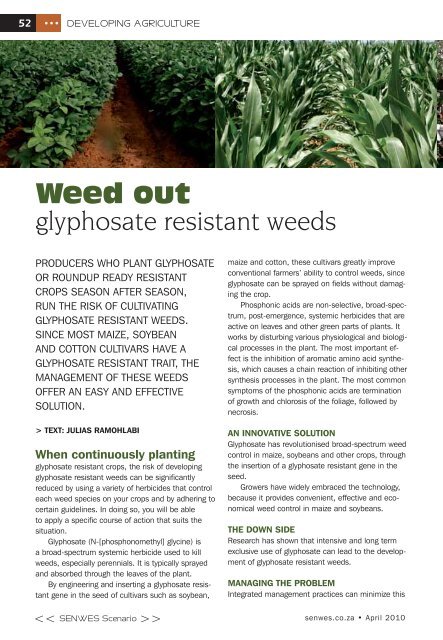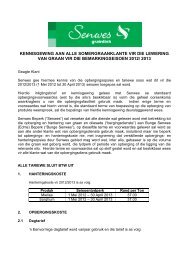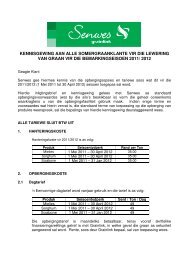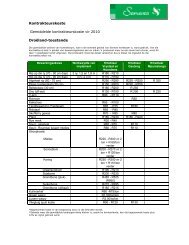scenario SENWES
scenario SENWES
scenario SENWES
Create successful ePaper yourself
Turn your PDF publications into a flip-book with our unique Google optimized e-Paper software.
52<br />
••• DEVELOPING AGRICULTURE<br />
Weed out<br />
glyphosate resistant weeds<br />
PRODUCERS WHO PLANT GLYPHOSATE<br />
OR ROUNDUP READY RESISTANT<br />
CROPS SEASON AFTER SEASON,<br />
RUN THE RISK OF CULTIVATING<br />
GLYPHOSATE RESISTANT WEEDS.<br />
SINCE MOST MAIZE, SOYBEAN<br />
AND COTTON CULTIVARS HAVE A<br />
GLYPHOSATE RESISTANT TRAIT, THE<br />
MANAGEMENT OF THESE WEEDS<br />
OFFER AN EASY AND EFFECTIVE<br />
SOLUTION.<br />
> TEXT: JULIAS RAMOHLABI<br />
When continuously planting<br />
glyphosate resistant crops, the risk of developing<br />
glyphosate resistant weeds can be significantly<br />
redu ced by using a variety of herbicides that control<br />
each weed species on your crops and by adhering to<br />
certain guidelines. In doing so, you will be able<br />
to apply a specific course of action that suits the<br />
situation.<br />
Glyphosate (N-[phosphonomethyl] glycine) is<br />
a broad-spectrum systemic herbicide used to kill<br />
weeds, especially perennials. It is typically sprayed<br />
and absorbed through the leaves of the plant.<br />
By engineering and inserting a glyphosate resistant<br />
gene in the seed of cultivars such as soybean,<br />
><br />
maize and cotton, these cultivars greatly improve<br />
conventional farmers’ ability to control weeds, since<br />
glyphosate can be sprayed on fields without damaging<br />
the crop.<br />
Phosphonic acids are non-selective, broad-spectrum,<br />
post-emergence, systemic herbicides that are<br />
active on leaves and other green parts of plants. It<br />
works by disturbing various physiological and biological<br />
processes in the plant. The most important effect<br />
is the inhibition of aromatic amino acid synthesis,<br />
which causes a chain reaction of inhibiting other<br />
synthesis processes in the plant. The most common<br />
symptoms of the phosphonic acids are termination<br />
of growth and chlorosis of the foliage, followed by<br />
necrosis.<br />
AN INNOVATIVE SOLUTION<br />
Glyphosate has revolutionised broad-spectrum weed<br />
control in maize, soybeans and other crops, through<br />
the insertion of a glyphosate resistant gene in the<br />
seed.<br />
Growers have widely embraced the technology,<br />
because it provides convenient, effective and econo<br />
mical weed control in maize and soybeans.<br />
THE DOWN SIDE<br />
Research has shown that intensive and long term<br />
exclusive use of glyphosate can lead to the development<br />
of glyphosate resistant weeds.<br />
MANAGING THE PROBLEM<br />
Integrated management practices can minimize this<br />
senwes.co.za • April 2010

















